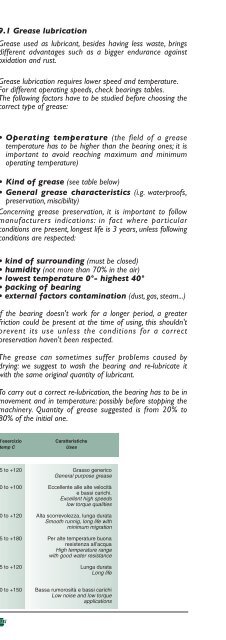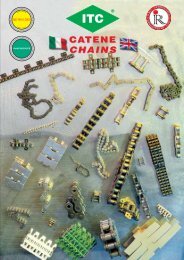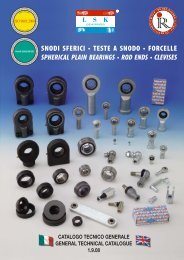ITALCUSCINETTI speed master
ITALCUSCINETTI speed master
ITALCUSCINETTI speed master
You also want an ePaper? Increase the reach of your titles
YUMPU automatically turns print PDFs into web optimized ePapers that Google loves.
Ruote libere ad astuccio<br />
Ruote libere ad astuccio con supporto<br />
Le ruote libere ad astuccio hanno come caratteristica<br />
principale il minimo ingombro radiale, possono trasmettere<br />
elevati momenti torcenti e permettono di realizzare<br />
dei gruppi compatti.<br />
Sono composte da un anello esterno con parete sottile<br />
e da elementi di bloccaggio (rullini) che vengono trattenuti<br />
e guidati da molle, ed hanno il vantaggio di garantire<br />
un contatto costante tra l'albero i rullini e le superfici<br />
di bloccaggio. Questo crea il presupposto di un elevata<br />
precisione d'innesto, anche se occorre tenere presente<br />
altri fattori come lubrificazione, tolleranze, frequenza<br />
d'innesto ecc. Per facilitare il montaggio delle<br />
ruote libere è necessario praticare uno smusso sia sull'alloggiamento<br />
che sull'albero. Le molle che trattengono<br />
i rullini possono essere costruite sia con materiale<br />
plastico che in acciaio, chiaramente se sono in plastica si<br />
possono raggiungere delle temperature d'esercizio più<br />
limitate, da -10° C. a +60° C., mentre se sono in acciaio<br />
si possono oltrepassare arrivando fino a -30°C. e<br />
+80°C. Le ruote con molle in acciaio sono indicate per<br />
applicazioni dove siano previste elevate frequenze d'innesto,<br />
tenendo ben presente di non sovraccaricare la<br />
ruota libera. Sull'astuccio viene indicato il senso di bloccaggio.<br />
Le ruote libere vengono fornite già lubrificate<br />
con grasso e trovano il loro impiego in molteplici applicazioni.<br />
Si ricorda inoltre che se viene utilizzato l'albero<br />
come pista di rotolamento, andrà rettificato e portato<br />
ad una durezza il più possibile vicino a quella dei rullini<br />
per avere così la possibilità di sfruttare al massimo la<br />
velocità di rotazione e la durata. Solitamente la prima<br />
lubrificazione è sufficiente per tutta la durata dì utilizzo<br />
della ruota libera; nel caso che ci fosse necessità di un<br />
ulteriore ingrassaggio può essere eseguito senza problema<br />
alcuno. Si consiglia per il montaggio di utilizzare<br />
apposito attrezzo forzando la ruota libera nella sede e<br />
facendo attenzione al senso di bloccaggio.<br />
Le ruote libere HF sono in grado di trasmettere solamente<br />
dei momenti torcenti, quindi le forze radiali<br />
devono essere supportate da cuscinetti aggiuntivi.<br />
Per ciò che riguarda le ruote libere con supporti HFL<br />
occorre che ciascun lato della ruota sia integrato con<br />
cuscinetti radiali, per avere quindi la possibilità di assorbire<br />
forze radiali.Al variare della dimensione dell'albero<br />
varia il tipo di cuscinetto che sì può utilizzare (o a strisciamento<br />
o a rotolamento).<br />
Tipologie ruote libere - Drawn cup roller clutches types<br />
Tipo-Type Caratteristiche-Characteristics<br />
HF Ad astuccio con molle in acciaio<br />
With steel springs<br />
HFL Con molle in acciaio e supporti ai due lati, cuscinetti a strisciamento o volventi<br />
With steel springs and lateral supports, crawling or rolling bearings<br />
9<br />
Drawn cup roller clutches<br />
Drawn cup roller clutches with bearing assembly<br />
Drawn cup roller clutches, thanks to their minimum radial<br />
dimension, are able to transmit high torque movements and<br />
to realise compact units.<br />
They are formed by a thin outer ring and by some clamping<br />
elements (needle rollers): these latter are guided and kept<br />
from springs and have the advantage to guarantee a<br />
constant contact among the shaft, the needle bearings and<br />
locking surfaces.<br />
This creates the presupposition to reach a very high<br />
coupling precision, even if some other important factors<br />
such as lubrication, tolerances, frequency of coupling must<br />
be considered.<br />
To facilitate the mounting of drawn cup roller clutches and<br />
bearing assemblies, a chamfer on both housing and shaft<br />
must be done.<br />
The springs keeping needle rollers can be made of steel or<br />
plastic, temperature suggested for plastic ones from -10°C.<br />
to +60°C. for steel ones from -30°C. to +80°C. Drawn cup<br />
roller clutches with steel springs are indicated for<br />
applications requiring frequent coupling operations,<br />
overloading are not allowed.<br />
Direction locking is indicated on the drawn cup: NBS drawn<br />
cup roller bearings are supplied lubricated with grease and<br />
can be used in many different applications.<br />
Shaft can be used as raceway: it must be grinded and its<br />
hardness has to be closed to needle roller one's: in this way<br />
both <strong>speed</strong> rotations and duration are at the maximum.<br />
Usually the first lubrication lasts for all drawn cup roller<br />
clutches life, but a further lubrication can be done without<br />
any problem.<br />
Drawn cup roller clutches are mounted by an appropriate<br />
tool with a simple press fit in their housings, particular<br />
attention has to be paid to direction locking.<br />
HF drawn cup roller clutches transmit only torque<br />
movements: radial forces, therefore, have to be supported by<br />
using further bearings<br />
Concerning drawn cup roller clutches with HFL support,<br />
both sides of them have to mounted with radial bearings as<br />
they are able to stand radial forces.<br />
When the dimension of the shaft changes, the type of<br />
bearing to use is different it can be sliding or rolling.





